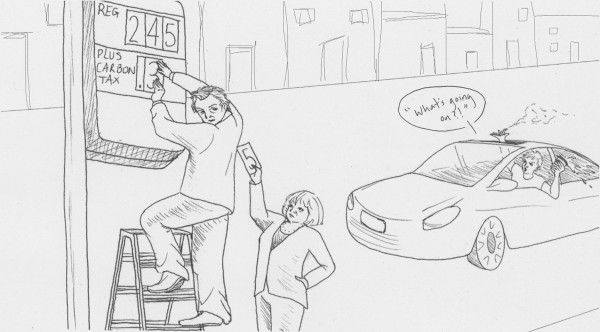
A new piece of legislation introduced by Assemblyman Kevin Cahill D-Kingston and co-sponsor Assemblywoman Barbara Lifton D-Ithaca seeks to implement a tax on carbon emissions starting at $35 per metric ton, followed by an increase of $10 annually up to $180 per metric ton. The purpose of this proposed tax is to reduce New Yorker’s consumption of fossil fuels that emit carbon, in hopes that they will start to rely on alternative green energy sources instead.
Considering the negative financial impacts a traditional carbon tax would have on the low and lower-middle income classes, the lawmakers look to refund 60 percent of its revenue to these groups. The other 40 percent of revenues will be utilized for supporting the ultimate goal of the bill which is to transition to cleaner energy in New York State.
We at The New Paltz Oracle remain supportive of this initiative, as it provides opportunity to integrate cleaner energy in the state without charging those who absolutely cannot afford it.
However, we do encourage a further comprehensive companion bill that will offer further subsidies for renewable forms of energy. The proposed legislation does encourage a penalty against carbon emissions and creates a progressive economic solution for the issue of climate change – yet what it lacks is a way to make clean energy more accessible.
Although the impact this piece of legislation will have on poor and lower-middle class New Yorkers would be minimal due to the refund, a difficulty in switching to alternative energy sources still stands. For many low and lower-middle income families, the opportunity to switch to a more fuel-efficient vehicle or even invest in solar panels for their homes will still be at a great cost.
Furthermore, we believe that a carbon tax will be much more convenient for those who already have public transportation at their disposal. In areas such as New York City or Long Island, citizens would have an upper-hand because since their way of travel will not be impeded as much as the lives of those who live in rural upstate New York.
In addition to transportation and the use of energy in the general lives of New Yorkers, we expect that certain jobs will be affected as well. It is possible that companies relying on these carbon-emitting fuels will have to fix salaries to compensate for the costly taxes imposed. The switch to alternative energy will become a secondary concern as companies which rely on carbon emitting fuels will be scrambling to balance increased costs to keep their business alive, and employees paid.
The fact that the bill would go into effect 90 days after being passed, does not give those who must prepare time to do so.
This type of legislature does encourage a financial reason to move away from fossil fuels; it will most likely be viewed as a type of penalty or punishment for those who use carbon emitting energy sources. In all, Cahill and Lifton should be commended by their constituents for making an effort in taking action against climate change and being in favor for a cleaner and greener New York in spite of the financial flaws the bill possesses.
The bill has the potential to be refined as an economically pragmatic piece of legislation. The state should aim to financially assist those who are heavily reliant on carbon-based enery, like farmers and miners, in making the transition over to a more sustainable energy system.
A solution we offer is in the form of a lower immediate tax, less than the proposed $35 per metric ton. In conjnction with a lower tax, we think the state should invest in the expansion of solar and wind energy programs, rather than putting the responsibility on tax payers to locate and develope their own alternative source of energy. This should be less of an initiative that punishes those struggling to keep up and one that encourages the collaboration of New York politicians and their constituents toward a clean, energized New York.
Editorials represent the views of the majority of the editorial board. Columns, op-eds and letters, excluding editorials, are solely those of the writers and do not necessarily represent the views of The New Paltz Oracle, its staff members, the campus and university or the Town or Village of New Paltz.
